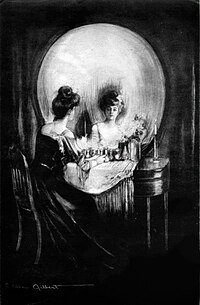Vanity
For other meanings of vanity, see vanity (disambiguation). For the Wikipedia page about so-called "vanity articles", see WP:COI.

Vanity is the excessive belief in one's own abilities or attractiveness to others. In some religious teachings vanity is considered a form of self-idolatry, in which one rejects God for the sake of one's own image, and thereby becomes divorced from the graces of God. The stories of Lucifer and Narcissus (who gave us the term narcissism), and others, attend to a pernicious aspect of vanity.
Friedrich Nietzsche wrote that "vanity is the fear of appearing original: it is thus a lack of pride, but not necessarily a lack of originality."[1] One of Mason Cooley's aphorisms is "Vanity well fed is benevolent. Vanity hungry is spiteful."[2]
In early Christian teachings vanity is considered an example of pride, one of the seven deadly sins.
The symbolism of vanity

In Western art, vanity was often symbolized by a peacock, and in Biblical terms, by the Whore of Babylon. In secular allegory, vanity was considered one of the minor vices. During the Renaissance, vanity was invariably represented as a naked woman, sometimes seated or reclining on a couch. She attends to her hair with comb and mirror. The mirror is sometimes held by a demon or a putto.
Other symbols of vanity include jewels, gold coins, a purse, and often by the figure of death himself. Often we find an inscription on a scroll that reads Omnia Vanitas ("All is Vanity"), a quote from the Book of Ecclesiastes.[1] "The artist invites us to pay lip-service to condemning her," writes Edwin Mullins, "while offering us full permission to drool over her. She admires herself in the glass, while we treat the picture that purports to incriminate her as another kind of glass—a window—through which we peer and secretly desire her."[2] The theme of the recumbent woman often merged artistically with the non-allegorical one of a reclining Venus.
In his table of the Seven Deadly Sins, Hieronymus Bosch depicts a bourgeois woman admiring herself in a mirror held up by a devil. Behind her is an open jewelry box. A painting attributed to Nicolas Tournier, which hangs in the Ashmolean Museum, is An Allegory of Justice and Vanity. A young woman holds a balance, symbolizing justice; she does not look at the mirror or the skull on the table before her.[3] Vermeer's famous painting Girl with a Pearl Earring is sometimes believed to depict the sin of vanity, as the young girl has adorned herself before a glass without further positive allegorical attributes. All is Vanity, by Charles Allan Gilbert (1873-1929), carries on this theme. An optical illusion, the painting depicts what appears to be a large grinning skull. Upon closer examination, it reveals itself to be a young woman gazing at her reflection in the mirror.
Such artistic works served to warn viewers of the ephemeral nature of youthful beauty, as well as the brevity of human life and the inevitability of death.
